lileep
Attributes
Stats
-
HP
-
Attack
-
Defense
-
Special Attack
-
Special Defense
-
Speed
Summary
Lileep is a dual-type Rock/Grass Pokémon introduced in Generation III.
Type: Rock / Grass
Abilities:
- Suction Cups: Prevents Lileep from being forced to switch out of battle.
- Storm Drain (Hidden Ability): Draws in all Water-type moves to boost Special Attack.
Physical Characteristics:
- Lileep resembles a plant-like creature with a purple, bulbous body.
- It has yellow eyes peering from its body and eight pink tentacles that resemble flower petals.
- Its appearance is reminiscent of a prehistoric sea lily or crinoid, with a stalk-like structure anchoring it in place.
Behavior and Habitat:
- Lileep is known to live in underwater habitats, often found on the ocean floor.
- It anchors itself to rocks or the seabed using its root-like lower body.
- As a fossil Pokémon, it is said to have been extinct but can be revived from a Root Fossil.
- Lileep is a passive Pokémon, using its tentacles to ensnare prey that comes too close.
In Battle:
- Lileep is known for its defensive capabilities, with high base stats in Defense and Special Defense.
- It typically uses moves such as Ingrain, which increases its staying power, and Ancient Power to boost its stats.
- Lileep can also learn Giga Drain to recover health while dealing damage.
- It is strong against Flying and Water types, but weak against Bug, Steel, and Fighting types.
Evolution:
- Lileep evolves into Cradily starting at level 40.
- This evolution further enhances its defensive capabilities and adds versatility to its move set.
Interesting Facts:
- Lileep is based on crinoids, marine animals that resemble plants and are often called "sea lilies."
- It was one of the first fossil Pokémon introduced to have dual types.
- Lileep's design is inspired by ancient, prehistoric life forms that thrived in the ocean over 500 million years ago.
- In the Pokémon world, Lileep fossils are often found in sedimentary rock layers, hinting at its ancient oceanic habitat.
Pokémon Sprites
Evolution Chain
Moves
Level Up
- Level 1: Wrap
- Level 1: Astonish
- Level 8: Constrict
- Level 15: Acid
- Level 21: Brine
- Level 22: Ingrain
- Level 29: Confuse Ray
- Level 36: Amnesia
- Level 36: Gastro Acid
- Level 43: Ancient Power
- Level 50: Stockpile
- Level 50: Spit Up
- Level 50: Swallow
- Level 50: Energy Ball
- Level 64: Wring Out
TM/HM
- Swords Dance
- Solar Beam
- Toxic
- Double Team
- Flash
- Rest
- Protect
- Sludge Bomb
- Sandstorm
- Giga Drain
- Attract
- Return
- Frustration
- Hidden Power
- Sunny Day
- Facade
- Secret Power
- Rock Tomb
- Bullet Seed
- Mud Shot
- Rock Blast
- Natural Gift
- Rock Polish
- Captivate
- Stealth Rock
- Grass Knot
- Smack Down
- Round
- Confide
- Infestation
Breeding
Tutor
Other
Flavor Text Entries
- Ruby: LILEEP became extinct approximately a hundred million years ago. This ancient Pokémon attaches itself to a rock on the seafloor and catches approaching prey using tentacles shaped like flower petals.
- Sapphire: LILEEP is an ancient Pokémon that was regenerated from a fossil. It remains permanently anchored to a rock. From its immobile perch, this Pokémon intently scans for prey with its two eyes.
- Emerald: It disguises itself as seaweed by making its tentacles sway. Unsuspecting prey that come too close are swallowed whole. It became extinct 100 million years ago.
- Firered: It became extinct roughly 100 million years ago. It was regenerated from a fossil using advanced techniques.
- Leafgreen: It became extinct roughly 100 million years ago. It was regenerated from a fossil using advanced techniques.
- Diamond: It lived on the seafloor 100 million years ago and was reanimated scientifically.
- Pearl: It lived on the seafloor 100 million years ago and was reanimated scientifically.
- Platinum: It lived on the seafloor 100 million years ago and was reanimated scientifically.
- Heartgold: It disguises its tentacles as flowers to attract and catch prey. It became extinct in ancient times.
- Soulsilver: It disguises its tentacles as flowers to attract and catch prey. It became extinct in ancient times.
- Black: It lived on the seafloor 100 million years ago and was reanimated scientifically.
- White: It lived on the seafloor 100 million years ago and was reanimated scientifically.
- Black-2: It lived on the seafloor 100 million years ago and was reanimated scientifically.
- White-2: It lived on the seafloor 100 million years ago and was reanimated scientifically.
- X: It disguises its tentacles as flowers to attract and catch prey. It became extinct in ancient times.
- Y: It lived on the seafloor 100 million years ago and was reanimated scientifically.
- Omega-Ruby: Lileep became extinct approximately a hundred million years ago. This ancient Pokémon attaches itself to a rock on the seafloor and catches approaching prey using tentacles shaped like flower petals.
- Alpha-Sapphire: Lileep is an ancient Pokémon that was regenerated from a fossil. It remains permanently anchored to a rock. From its immobile perch, this Pokémon intently scans for prey with its two eyes.
- Ultra-Sun: In ancient times, it lived in warm seas. It disguised itself as seaweed to ambush its prey and devoured them whole when they got close.
- Ultra-Moon: It sticks to rocks with its powerful suckers and can’t be washed away no matter how rough the surf gets.
- Sword: This Pokémon was restored from a fossil. Lileep once lived in warm seas that existed approximately 100,000,000 years ago.
- Shield: Lileep clings to rocks on the seabed. When prey comes close, this Pokémon entangles it with petallike tentacles.
Cards

Created by Suwama Chiaki for the Unknown Set set.
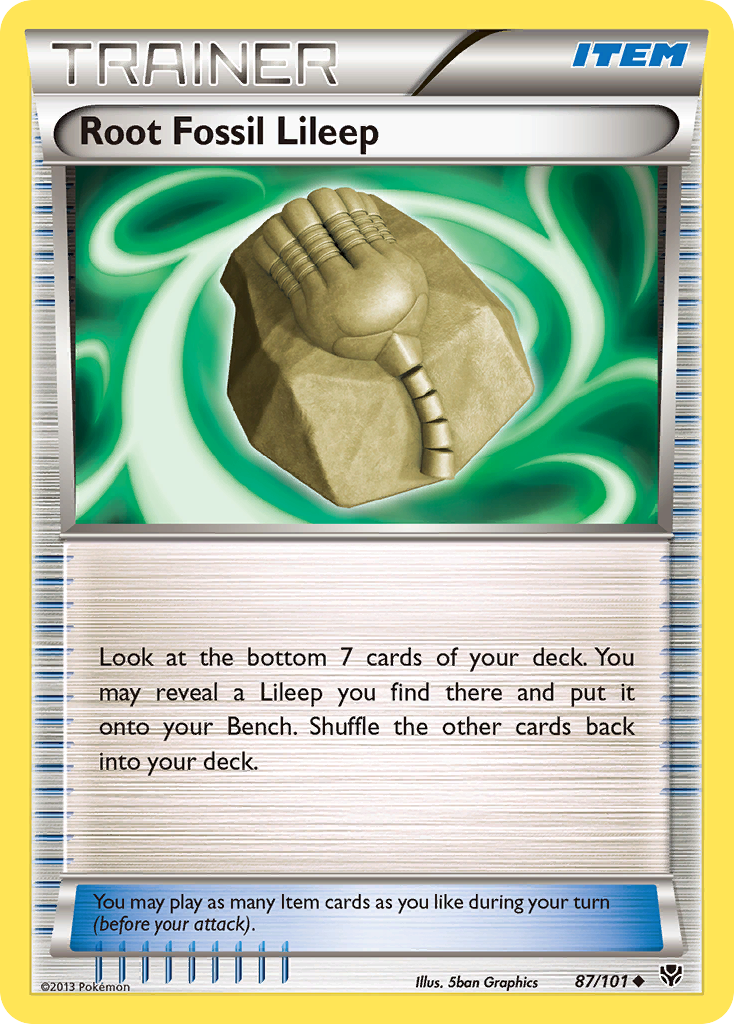
Created by 5ban Graphics for the Unknown Set set.
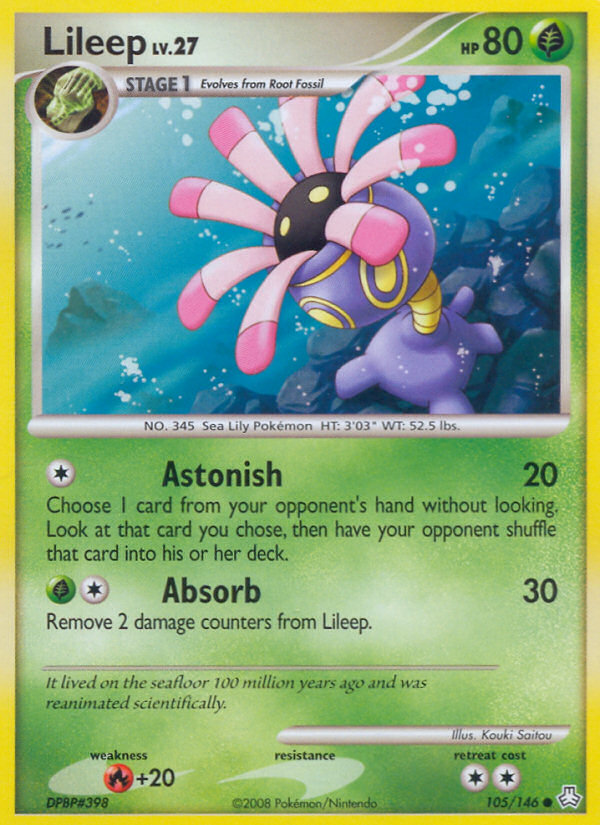
Created by Kouki Saitou for the Unknown Set set.

Created by Atsuko Nishida for the Unknown Set set.
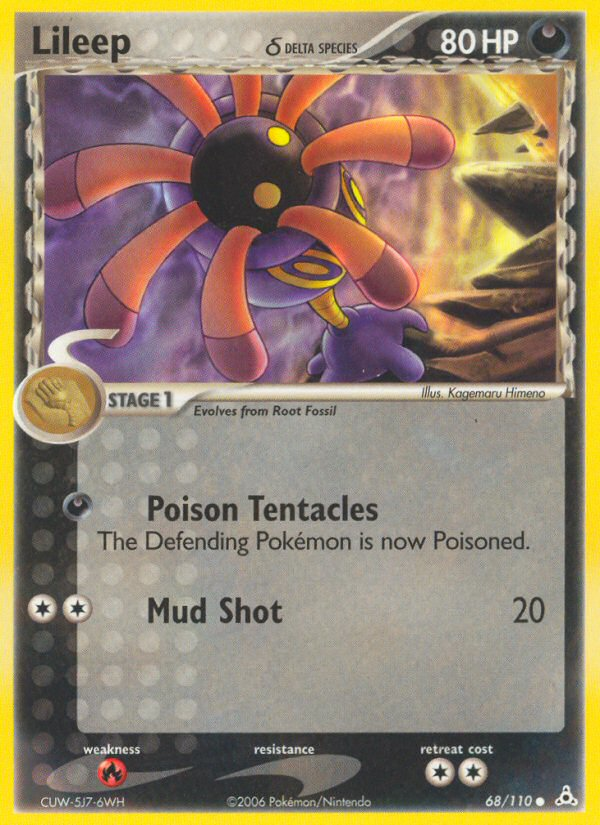
Created by Kagemaru Himeno for the Unknown Set set.
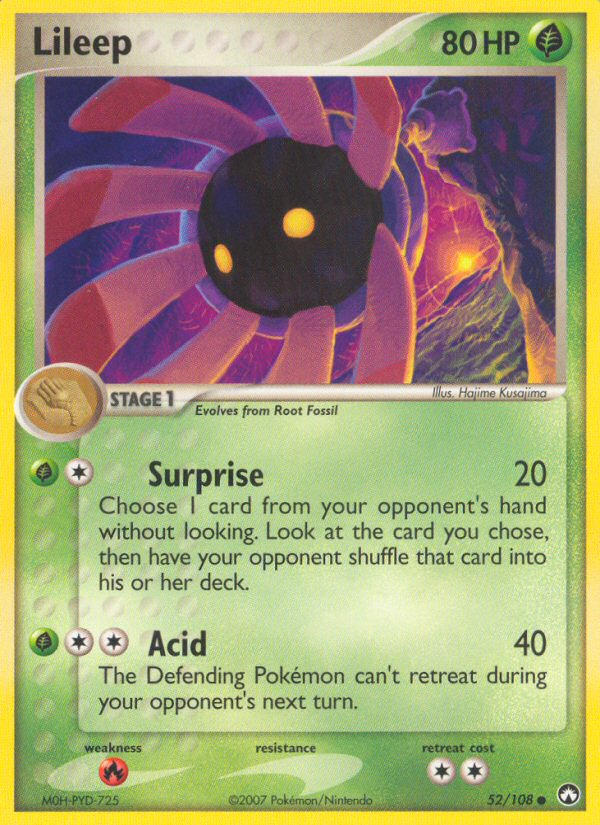
Created by Hajime Kusajima for the Unknown Set set.
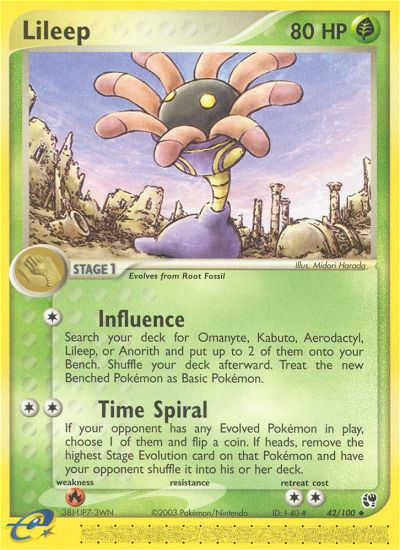
Created by Midori Harada for the Unknown Set set.

Created by Ken Sugimori for the Unknown Set set.

Created by Misa Tsutsui for the Unknown Set set.
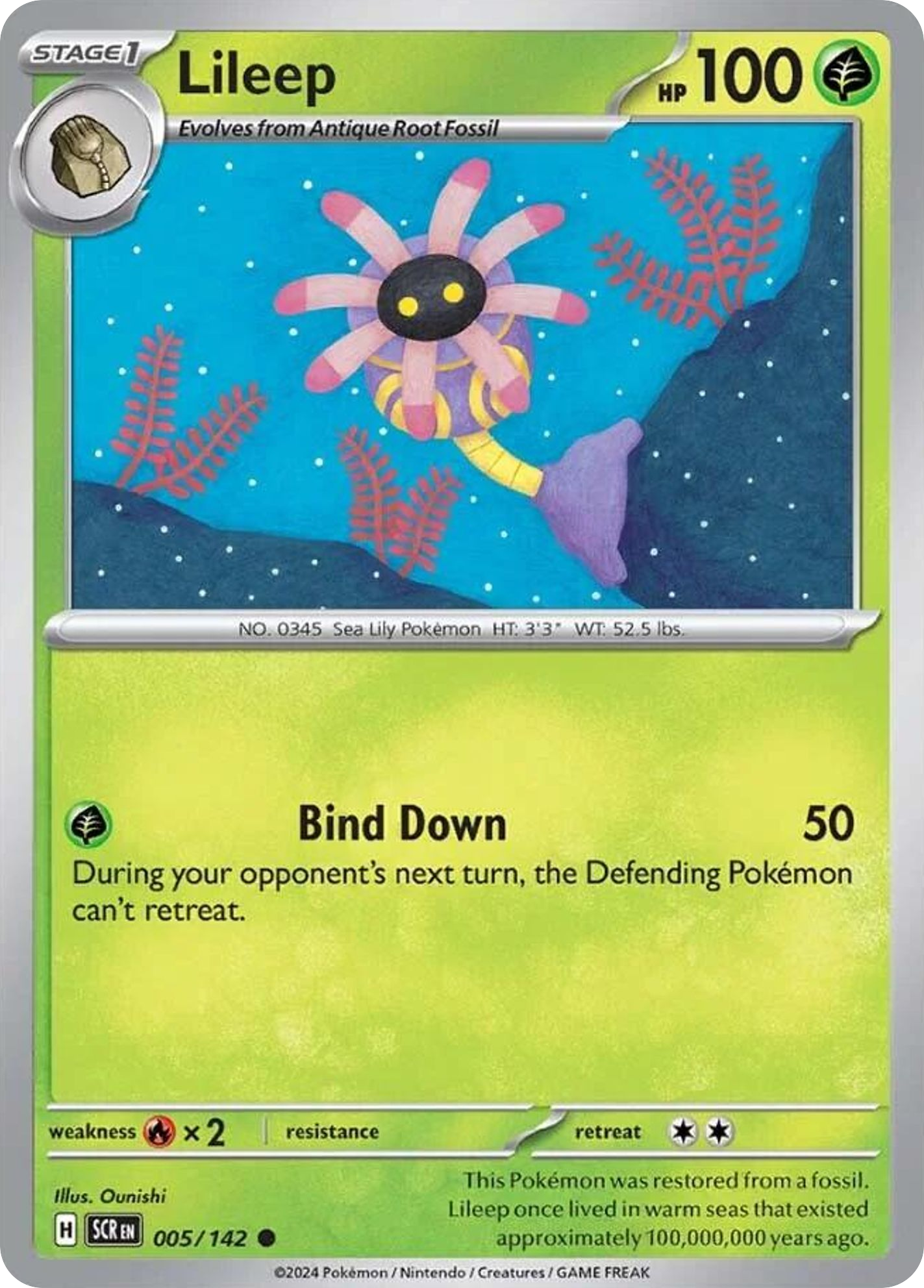
Created by Unknown for the Unknown Set set.
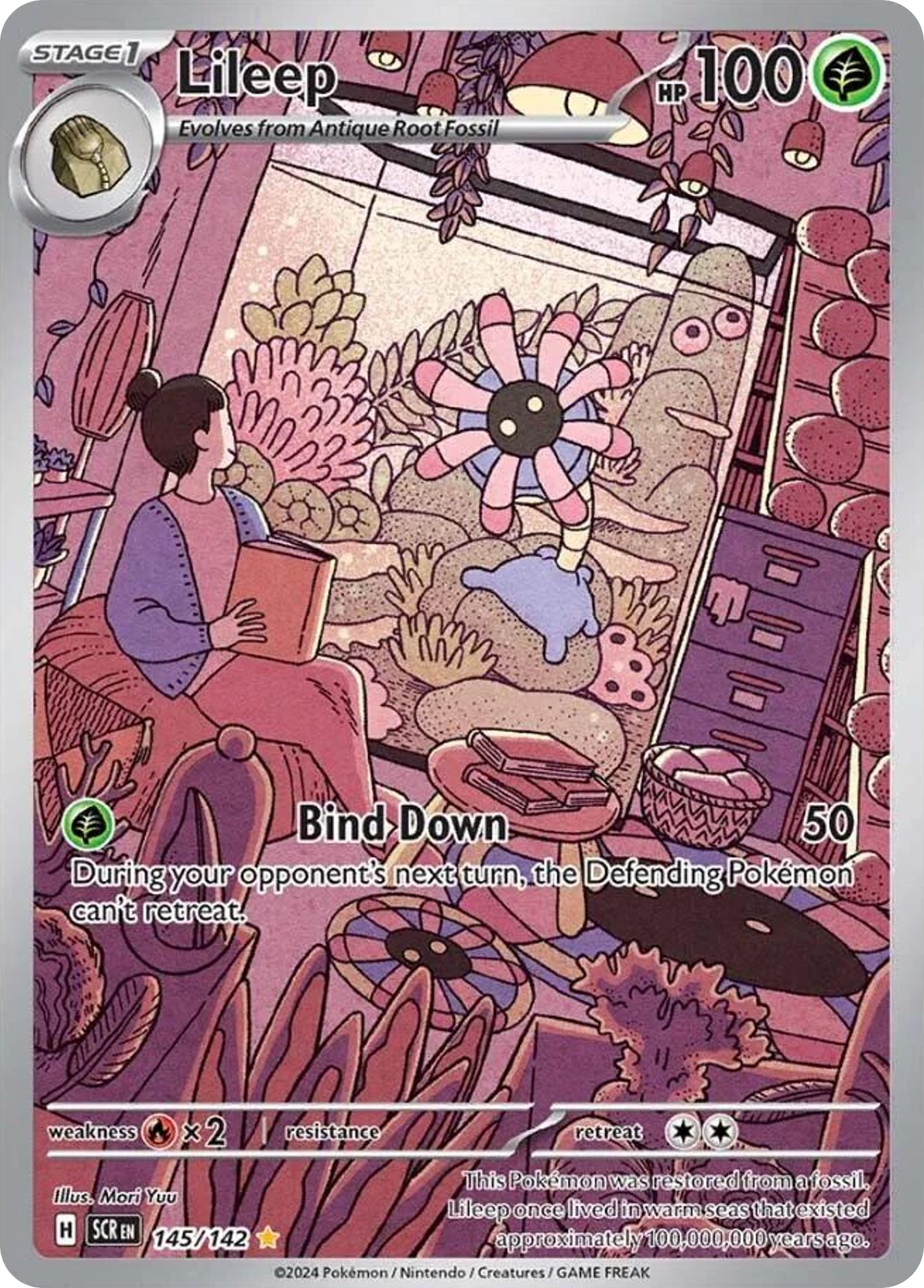
Created by Unknown for the Unknown Set set.